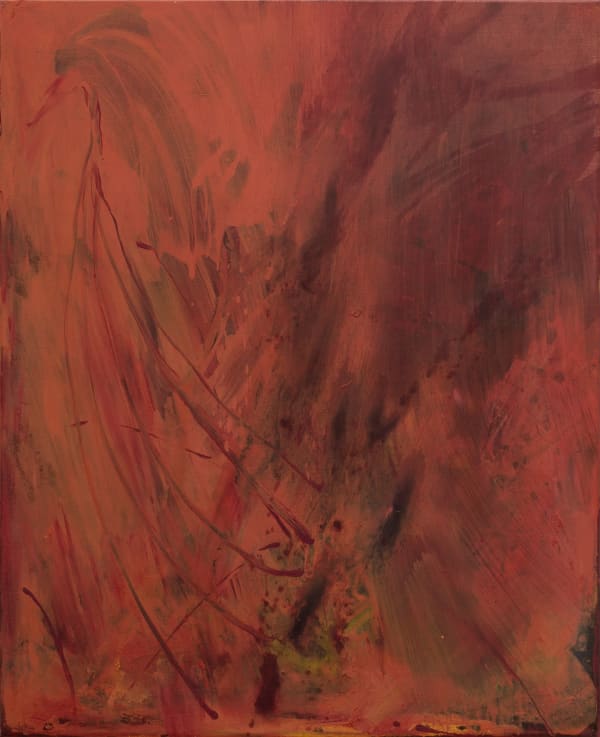Tyne Gordon, Sourdust
"THESE ARE PAINTINGS THAT OFFER A WAY TO STAND AT THE PRECIPICE, AND STAY THERE, JUST LONG ENOUGH TO THROW A ROCK INTO ITS CAVERN AND HEAR IT RICOCHET AT THE BOTTOM."
We are pleased to present an exhibition of new work by Tyne Gordon – Sourdust.
Tyne Gordon graduated from Ilam School of Fine Arts and lives in Ōtautahi, Christchurch. Recent exhibitions include: Wet Plate, Jonathan Smart Gallery, Suntrap, Jhana Millers, Yore, Laree Payne Gallery.
“Sourdust comprises a body of work which is at once airborne and gutterbound.
These are paintings that offer a way to stand at the precipice, and stay there, just long enough to throw a rock into its cavern and hear it ricochet at the bottom.
As if a screen or recording device, the paintings are able to broadcast from somewhere deep below into the contemporary, and back from there as well. There is a transtemporal dialogue present, embedded in the energy of debris crystallised in the works’ frames or in the built-up textures that have calcified through months of scavenging and layering. This is not astral, but an intense tuning-in to the frequencies of particles as they have existed throughout time, and allowing this to shimmer.”
Extracts from the essay, Blood Blossom: words for Tyne Gordon’s Sourdust, by Jane Wallace that will accompany the exhibition.
BLOOD BLOSSOM: WORDS FOR TYNE GORDON’S SOURDUST
An encounter with beauty, Elaine Scarry writes, acquaints us to the mental event of conviction, a condition that impels an ongoing struggle to locate enduring forms of this feeling.1 This is to say that it might be energetic, convulsive, an electric shock to the system. I sense that this is also true when confronted with other emotions at extremes. The devastation of beauty is delivered through awe, and uncoincidentally, the perception of awe indicates the advent of fear too: awesome and awful are divided by a very narrow chasm. This dichotomy between terror and carnival underscores Tyne Gordon’s show Sourdust, a body of work which is at once airborne and gutterbound.
A shock; a pulse of survival. How do we stay with this feeling, or find a source for it so as to make it immortal? There is something analogous to mining going on in Tyne’s work, divining through wrought territories for things that vibrate with evidence of earlier instances of the sacred. And so, this is a search that is about looking before, for precedents. We travel backwards, chronologically. Now, time-keeping is implicated; an excavation with a sundial. The annals cry, dredged from a murky grave and cast into a new one, framed by peat and concrete. Underground, a tablet throbs with information buried for another epoch.
As if screens or recording devices, the paintings in Sourdust are able to broadcast from somewhere deep below into the contemporary, and back from there as well. There is a transtemporal dialogue present, embedded in the energy of debris crystallised in the works’ frames and built-up textures that have calcified through months of scavenging and layering. This is not astral, but an intense tuning-in to the frequencies of particles as they have existed throughout time. In several works, the skin of a ribbon has been pressed to the surface, so that in places, its metallic coating has flecked off. This indexical relationship means that the physicality of the object is intrinsic to the work–a loose and looping memory of a past party. The same is true for the subtle woodcut prints that are bedded in the backgrounds of Sourdust.
Prize II bursts outward as a radial wound. The resulting image is formed by a visible configuration of positive and negative.
Pressed to the painting, the ribbon resembles language. It is matter that can uncoil from the tongue and be endlessly reconfigured. Across Chlorine, it is a diagonal filament into its depths; conversely, the marks in Channel are tight and broken. They hold a latent hum, like a swarm of winged insects or vibrating atoms, or the swill of silt and dirt that remains when you take the plug out of the sink and let it empty down the drain. This compressed motion is charged with kinetic potential: migrating, dispersing, seething, a murmuration of painterly missiles.
Siouxsie Sioux, in the Banshees’ single “Dazzle,” sings skating bullets on angel dust / in a dead sea of fluid mercury. A chain of diamonds, studded into the pixels of the clip, studded into Sioux’s eyelids, melt into a silver pool, their cut-throat facets of the verse earlier now toxic fluid. As with the ribbon forms on the surface of Tyne’s paintings, the slippage between states is a mode of communication unto itself, not illustrative, but a thing to follow beyond the bounds of the song. It is akin to the effect of slowing down a stream of water until it falls in beads, but in the inverse, speeding solid matter up until it is a cascade.
That which is beautiful is often re-coded as portent of horror, and more specifically, of a domestic kind, where innocence and familiarity are distorted behind closed doors. Outside, high sun is blaring, yet the curtains are drawn and the television is on. Rosy is seared by the caustic mood of a migraine or a comedown. It is always too bright, too loud. A wing of buttermilk thrashes the centre of Rosy, blurring the divide between its light and dark sides. The title reminds me of plague and the gentle melding of nursery rhyme and death, and so this pale yellow focal point reads as a spectre passing through two realms. Sourdust’s ribbony reach is a topographical guide for these worlds. These are paintings that offer a way to stand at the precipice, and stay there, just long enough to throw a rock into its cavern and hear it ricochet at the bottom.
Jane Wallace
1. Elaine Scarry, “On Beauty and Being Just,” The Tanner Lectures on Human Values, delivered at Yale University, March 25-26, 1998.




















